SPECIAL PROJECT: The Summer of Love
Ex-IBM photographer Jamie Robertson makes a selection from his file of 2000, a photographic trip through Linux user land…In early 2001, computer giant IBM commissioned artist-photographer Jamie Robinson to create the photographic narrative for an international advertising campaign entitled PEACE, LOVE, LINUX. Scheduled for release in September of that year, its hippy-esque strapline would have declared IBM’s allegiance to the Linux open systems principle, and placed the old ‘Big Blue’ in a politically invigorating alliance with mascot of the moment, the Linux penguin. Against the backdrop of Microsoft’s wobbly hegemony, the brief was to catch the self-declared Revolution as it happened, and Robinson was duly flown around the world’s alternative production hubs to document the lives, loves and work of the Linux community. The trip happened. As did the photographs. But, for reasons known only to those at the top, the full campaign did not. An unpopular ‘guerilla marketing’ teaser on the pavements of Chicago may have played a small role in the mysterious turnaround; that of September 11 and the continuing net slump was likely more decisive. Two years later, in an utterly changed climate, Robinson is sitting on a rich historical document. The following pages are a small section.
>UNIX Development Begins
1969 >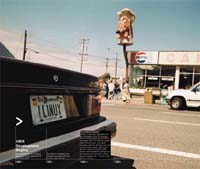 Bell Labs Researcher Ken Thompson begins work on the program that will later become UNIX.
Bell Labs Researcher Ken Thompson begins work on the program that will later become UNIX.
1973 >The system is completed by Ken Thompson and another Bell Labs researcher, Dennis Richtie.
1984 >Free Software FoundationPartially in response to legal battles over the copyrighting of Unix, MIT graduate Richard Stallman starts the Free Software Foundation at MIT. The FDF’s first project is GNU (Gnu’s Not Unix), a Unix-based operating system for which the code would be kept publicly available. Stallman also devises ‘copyleft’ and the GNU public licence, which stipulates that software can be improved upon and sold for profit as long as it remains ‘free’ – not as in/ gratis/ but as in ‘at liberty’.
1990 >Richard Stallman wins a MacArthur Grant
1991 >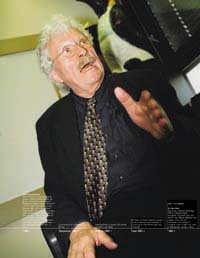 Linus Conceives LinuxLinus Torvalds, a 21-year-old computer science student in Finland, develops the kernel – the centre of communications between the operating system and the CPU – for a PC based, free operating system that uses GNU. Linux is later released under the GNU Public License. ‘I’m doing a (free) operating system,’ Linus writes on the newsgroup_ comp.os.minix, 3 Jul 91. ‘_Just a hobby, won’t be big and professional like gnu) [...] I’d like to know what features most people would want... I won’t promise I’ll implement them :-) Linus’
Linus Conceives LinuxLinus Torvalds, a 21-year-old computer science student in Finland, develops the kernel – the centre of communications between the operating system and the CPU – for a PC based, free operating system that uses GNU. Linux is later released under the GNU Public License. ‘I’m doing a (free) operating system,’ Linus writes on the newsgroup_ comp.os.minix, 3 Jul 91. ‘_Just a hobby, won’t be big and professional like gnu) [...] I’d like to know what features most people would want... I won’t promise I’ll implement them :-) Linus’
September 1991 >Linux version 0.01 is released and put on the net.
October 1992 >Peter MacDonald announces SLS, the first standalone Linux install.
June 1993 >Slackware, by Patrick Volkerding, becomes the first commercial Linux standalone. It proves popular within the emerging Linux community.
1994 >Linux 1.0 is released.
Red Hat debutsMarc Ewing, a graduate of Carnegie Mellon’s computer science department, and Robert Young, the head of a free software distributor, join together to form Red Hat , a commercial Linux distributor. A competitor is also formed in the shape of software sales company, Caldera.
June 1994 >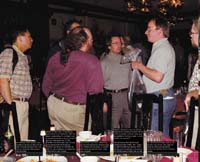 Jon ‘Mad Dog’ Hall persuades Linus Torvalds to port Linux to DEC’s 64-bit Alpha computer processor chip. Less than two weeks later, DEC agrees to fund the project.
Jon ‘Mad Dog’ Hall persuades Linus Torvalds to port Linux to DEC’s 64-bit Alpha computer processor chip. Less than two weeks later, DEC agrees to fund the project.
August 1994 >William R. Della Croce, Jr. registers the trademark ‘Linux’ in September, 1994, and begins sending letters to prominent Linux companies demanding money for its use. A lawsuit is filed against him in 1996. Plaintiffs in the suit include Linus Torvalds, Linux International and WorkGroup Solutions (also known as LinuxMall). By 1997 the case is settled by the assignment of the mark to Linus Torvalds.
1997 >Bliss, the first ‘Linux virus’ is discovered. Eric Raymond delivers his influential paper ‘The Cathedral and the Bazaar’, in support of the Linux development model , at the Linux Kongress.
January 1998 >Netscape announces a new free software license for its commercial browser. Has the world of proprietary software woken up to the potentials of the Linux model, or is this just dot com craziness?
Red Hat launches Red Hat Advanced Development Labs (RHAD). Here, coders are paid to develop free software. RHAD later becomes an important component of the GNOME Desktop Project (see July 98).
February 1998 >Eric Raymond and friends come up with the term ‘open source’. They apply for trademark status and develop the Opensource.org (Open Source Initiative) website.
March 1998 >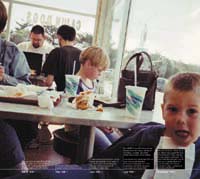 Consumer advocate Ralph Nader asks the large PC vendors (Dell, Gateway, Micron, etc.) to offer non-Microsoft systems, including systems with Linux installed.
Consumer advocate Ralph Nader asks the large PC vendors (Dell, Gateway, Micron, etc.) to offer non-Microsoft systems, including systems with Linux installed.
May 1998 >The Google search engine debuts. Famously robust, it is based on Linux.
June 1998 >A Datapro survey shows that Linux has the highest user satisfaction of any system; it also shows Linux to be the only system other than Microsoft Windows NT increasing its market share.
July 1998 >The GNOME Project (GNU Network Object Model Environment) begins, with the aim of building a complete, user-friendly desktop based entirely on free software.
Linux desktop wars rage between KDE (an open source graphical desktop environment designed for use on Unix workstations) and GNOME advocates. Linus comes out in favour of KDE.
September 1998 >Microsoft admits it is ‘worried’ about free software and suggests that some of its Windows NT source code may be made available to developers. The same month Microsoft goes on to list Linux as a competitive threat in its annual Securities and Exchange Commission) filing... to influence its upcoming antitrust trial?
December 1998 >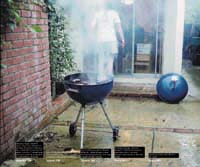 Technology industry analyst IDC reports a rise of Linux shipments of more than 200 percent in 1998, and a rise in market share of more than 150 percent. Linux has a 17 percent market share and a growth rate unmatched by any other system on the market.
Technology industry analyst IDC reports a rise of Linux shipments of more than 200 percent in 1998, and a rise in market share of more than 150 percent. Linux has a 17 percent market share and a growth rate unmatched by any other system on the market.
January 1999 >Linus Torvalds announces the arrival of the next generation of Linux, version 2.2, with a simple note to the Linux-kernel mailing list.
February 1999 >Linux and BSD users unite for ‘Windows Refund Day’, visiting Microsoft to return the Windows licenses that they were forced to acquire with their computers.
March 1999 >VA Research buys the_ Linux.com_ domain for $1,000,000 and announces plans to turn it into a Linux portal. Microsoft is also rumoured to bid for the domain.
August 1999 >Red Hat has its initial public offering, at $50 a share.
September 1999 >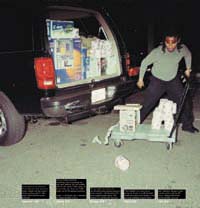 On the back of the dot com boom, the first big Linux stock rush occurs. Shares in Applix more than double in volume, reaching nearly 27 million shares. Stock in Red Hat reaches $135/share.
On the back of the dot com boom, the first big Linux stock rush occurs. Shares in Applix more than double in volume, reaching nearly 27 million shares. Stock in Red Hat reaches $135/share.
January 2000 >VA Linux Systems announces SourceForge, a tool for producing free code which makes its own code available under the FSF’s General Public Licence. By the end of the year, it hosts over 12,000 projects and 92,000 registered developers.
Version 1.0 of Red Flag Linux is released in the People’s Republic of China.
February 2000 >IDC reports that Linux ranks as the ‘second-most-popular operating system for server computers’, with 25 percent of the server operating system sales in 1999. Windows NT is still first with 38 percent.
March 2000 >The Embedded Linux Consortium is announced. Its goal: ‘to amplify the depth, breadth and speed of Linux adoption in the enormous embedded computer market.’
April 2000 >Andy Tanenbaum releases the Minix operating system under the BSD license, initiating what will later become the BSD / Linux war.
May 2000 >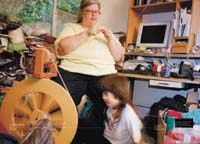 SuSE releases the first supported Linux distribution for the IBM S/390 mainframe.
SuSE releases the first supported Linux distribution for the IBM S/390 mainframe.
July 2000 >Oracle’s Linux-based internet appliance system, the `New Internet Computer’ (NIC) is put on sale at $199, without monitor. It is an ongoing part of Larry Ellison’s attempt to challenge Bill Gates’ dominance of the PC.
August 2000 >HP, Intel, IBM and NEC announce the Open Source Development Lab, which makes large hardware available to Linux developers for benchmarking and testing.
December 2000 >IBM announces plans to invest $1 billion in Linux in 2001.
January 2001 >The long-awaited 2.4.0 kernel is released.
The US National Security Agency (NSA) releases SELinux, also under the GPL. SELinux offers an additional layer of security checks in addition to the standard UNIX-like system.
March 2001 >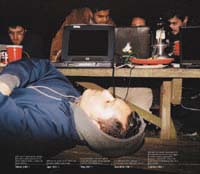 The Linux 2.5 kernel summit, perhaps the most complete gathering of Linux kernel hackers in history, is held in San Jose, California.
The Linux 2.5 kernel summit, perhaps the most complete gathering of Linux kernel hackers in history, is held in San Jose, California.
April 2001 >IBM gets into trouble over its ‘Peace, Love and Linux’ graffiti in several cities
May 2001 >Sony’s PlayStation Linux kit, shipped in Japan, sells out in eight minutes despite a doubling of the available stock.
December 2001 >LinuxBangalore/2001 Conference. A crucial event for the Asian Linux economy.
January 2002 >Teenager Jon Johansen prosecuted by the Norwegian Economic Crime Unit for trying to access the data on his own DVD. Johansen created DeCSS, software that could enable DVD playback on Linux. He is later acquitted.
May 2002 >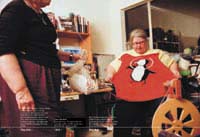 United Linux – four Linux vendors (Caldera International Inc., SuSE Linux AG, Conectiva SA and Turbolinux Inc.) pool their resources to create and sell a standardised enterprise version of Linux. They want to increase its adoption in business computing... and make a play against Red Hat, dominating the Linux market.
United Linux – four Linux vendors (Caldera International Inc., SuSE Linux AG, Conectiva SA and Turbolinux Inc.) pool their resources to create and sell a standardised enterprise version of Linux. They want to increase its adoption in business computing... and make a play against Red Hat, dominating the Linux market.
2003 >Linux Eats Unix?Research group IDC predicts the Linux operating system will take market share from the Unix operating system.
May 2003 >The Thai government aims to deliver a million low-cost desktop and laptop computers to the poor within 18 months. The computers will run Thai – language Linux operating systems.
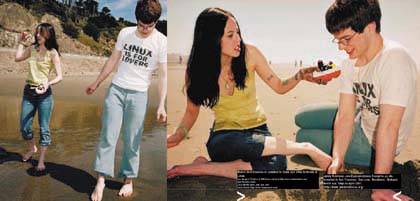
Mute’s brief timeline is indebted to these and other histories of Linux:Jorn Barger’s Timeline of GNU/Linux and Unix [http://www.robotwisdom.com/ linux/timeline.html]Linux Weekly News [http://lwn.net]Linux Journal [http://www.linuxjournal.com]
Jamie Robinson <me@jamierobinson.freeserve.co.uk> travelled to San Francisco, San Jose, Stockholm, Stuttgart, Berlin and Tokyo in April 2001. [http://www.jamierobinson.org]
Mute Books Orders
For Mute Books distribution contact Anagram Books
contact@anagrambooks.com
For online purchases visit anagrambooks.com







